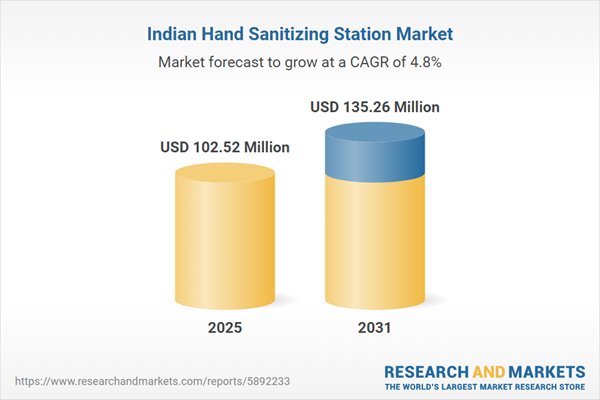Speak directly to the analyst to clarify any post sales queries you may have.
10% Free customizationThis report comes with 10% free customization, enabling you to add data that meets your specific business needs.
Government cleanliness initiatives and corporate emphasis on workplace safety are further supporting adoption. Technological developments, including IoT-enabled dispensers with monitoring features, are reshaping usage patterns. Additionally, the rise of e-commerce - reflected by a USD 60 billion GMV in FY23 - has facilitated wider product availability, enhancing reach across urban and semi-urban regions. This expanding digital presence is reinforcing the long-term demand and accessibility of hand sanitizing stations throughout India.
Key Market Drivers
Heightened Public Awareness of Hygiene and Health Safety
Public health consciousness has emerged as a primary growth driver for the hand sanitizing station market in India. The COVID-19 pandemic significantly influenced individual and institutional attitudes toward hygiene, establishing hand sanitizers as an everyday necessity. Increased awareness of hand hygiene’s role in mitigating the spread of communicable diseases, including seasonal flu and bacterial infections, has led to sustained demand for sanitizing solutions. Sectors such as healthcare, retail, education, and hospitality have integrated sanitizing stations into their hygiene protocols, with touchless dispensers becoming common at facility entrances, restrooms, and high-traffic zones. These shifts in behavior, reinforced by public safety campaigns and corporate policies, are expected to support long-term demand and embed hand sanitizing stations as standard infrastructure in both public and private settings.Key Market Challenges
High Maintenance and Operational Costs
Despite their hygiene benefits, automatic and sensor-based sanitizing stations involve considerable maintenance and operational expenses, particularly in high-footfall locations. Frequent refilling, cleaning, and potential technical servicing - such as battery replacement or sensor recalibration - can drive up total costs. Malfunctions caused by lack of maintenance, including leakage or inconsistent dispensing, impact user experience and reduce confidence in the system. For smaller businesses or budget-constrained public entities, these ongoing costs may hinder adoption. Additionally, rural and semi-urban areas with limited infrastructure and staffing support face challenges in maintaining these units, which can limit market expansion beyond Tier 1 and Tier 2 cities. The need for trained personnel further compounds the issue, making operational sustainability a key concern.Key Market Trends
Rapid Adoption of Touchless and Sensor-Based Sanitizing Stations
The increasing preference for touch-free hygiene solutions is a defining trend in India’s hand sanitizing station market. Following heightened awareness of surface-based disease transmission, consumers and institutions are prioritizing sensor-based systems that reduce physical contact. These dispensers, which operate using motion or proximity sensors, are gaining popularity in sectors such as public transport, retail, healthcare, and education. They offer a more hygienic and user-friendly experience, especially in high-traffic environments. Manufacturers are introducing advanced features like adjustable dispensing, infrared sensors, and compatibility with gel or liquid formulations. This trend reflects a broader shift in hygiene expectations and is expected to continue as touchless solutions become the new standard across both public and private sectors.Key Market Players
- Dolphy India Pvt. Ltd.
- Staietech LLP
- Euronics Industries Pvt Ltd.
- Conmed Devices Pvt Ltd.
- BPE Innovations Pvt Ltd.
- NR Hygiene Solutions
- Sudhai AirTech Private Limited
- Mazaf Inetrnational Agencies Pvt Ltd.
- Kwick Living Pvt Ltd. (Beco)
- Bluepoint Office Solutions
Report Scope:
In this report, the India Hand Sanitizing Station Market has been segmented into the following categories, in addition to the industry trends which have also been detailed below:India Hand Sanitizing Station Market, By Type:
- Floor Standing
- Wall Mounted
India Hand Sanitizing Station Market, By Mode of Operation:
- Automatic
- Manual
India Hand Sanitizing Station Market, By Distribution Channel:
- Direct Sales
- Indirect Sale
India Hand Sanitizing Station Market, By Region:
- North
- South
- East
- West
Competitive Landscape
Company Profiles: Detailed analysis of the major companies present in the India Hand Sanitizing Station Market.Available Customizations:
With the given market data, the publisher offers customizations according to a company's specific needs. The following customization options are available for the report.Company Information
- Detailed analysis and profiling of additional market players (up to five).
This product will be delivered within 1-3 business days.
Table of Contents
Companies Mentioned
- Dolphy India Pvt. Ltd.
- Staietech LLP
- Euronics Industries Pvt Ltd.
- Conmed Devices Pvt Ltd.
- BPE Innovations Pvt Ltd.
- NR Hygiene Solutions
- Sudhai AirTech Private Limited
- Mazaf Inetrnational Agencies Pvt Ltd.
- Kwick Living Pvt Ltd. (Beco)
- Bluepoint Office solutions
Table Information
| Report Attribute | Details |
|---|---|
| No. of Pages | 80 |
| Published | July 2025 |
| Forecast Period | 2025 - 2031 |
| Estimated Market Value ( USD | $ 102.52 Million |
| Forecasted Market Value ( USD | $ 135.26 Million |
| Compound Annual Growth Rate | 4.7% |
| Regions Covered | India |
| No. of Companies Mentioned | 10 |









